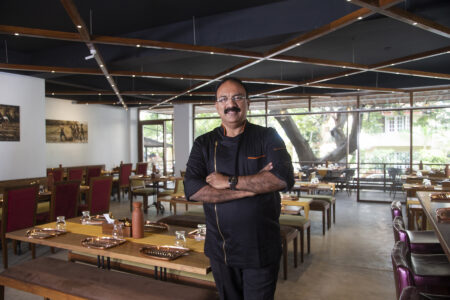“ Eat warm for afternoon tea,” wrote Flora Annie Steel and Grace Gardiner, way back in 1888. She was talking about a freshly baked cake in a chapter on baking breads, cakes and biscuits in India.
On a plantation, miles from anywhere, you truly appreciated the sweet pleasures of seeing a soft, fragrant, just baked cake on the tea table. But baking was something of a challenge. A peek into the flour bin usually revealed plenty of small, active wildlife. Unless you had a trip planned to the nearest town – a long journey on roads that wound dizzyingly down steep hillsides – you just popped the flour into a warm oven, exterminated the wildlife, and carried on with your baking plans. Ovens were enormous, country-made, wood-fired beasts that required a certain kind of genius to handle. If you happened to be the owner of a British made Belling range – always cream or pale blue in colour – you could consider yourself the queen of baking circles: provided the erratic electricity supply did not choose to play its infuriating game of hide and seek just when you had your cake batter mixed and ready.

Cake tins were mostly newspaper lined, battered aluminum affairs; cones and quills of rolled up newspaper doubled as icing bags and piping nozzles. And yet I knew cooks who had regular baking days, and turned out the most delicious cakes, experimenting with local flavours and spices. There was a simple, airy ‘cream cake’ made with the week’s accumulated milk toppings; cakes from which exotic whiffs of cardamom and cinnamon rose and dragged you towards the table; marble cake which was considered quite a wonder in its time, and the ever popular ‘seed cake’, perfect with a cup of tea. All of these emerged from a confusion of imagination, skill and primitive kitchen equipment. Here is Isobel Abbot writing about her cook and his oven, many long decades before I was to experience plantation kitchens myself: “His oven was a kerosene tin placed on an open wood fire, with a few burning embers placed on the top of the tin to produce an even heat. One had to be a past master to keep the fire at just the right temperature.” From this miserably equipped and messy kitchen, “a beautifully iced and decorated layer cake always serenely reposed on the kitchen stool,” she wrote.

Date and walnut cake comes from somewhere down that long list of creations, the recipe copied out neatly on the pages of a handwritten recipe book many years ago. Every slice holds the warm, heady whiff of dark rum; sweet, squelchy dates and the crunch of walnuts, to be enjoyed with a cup of freshly brewed tea – even whipped cream or, as I have recently discovered, with a generous scoop of salted caramel sauce.
Even in the late 1990’s and into the 2000’s, several times a year we travelled to one of the most beautiful tea plantation bungalows in the Nilgiris. Every evening at 5 o’clock, a mellow lace tablecloth would be spread over a round table on which, amidst home made scones, butter, jam and all sorts of enticements arranged on pretty china, would sit a warm, freshly baked cake. The cook was a round, bespectacled man who was an absolute virtuoso in the kitchen. He emerged at every meal, after the butler had served up his creations, laughing benignly, absorbing all our adulation, but never once parting with a recipe, while we sank comfortably into the faded, but still delightful luxuries of plantation style.
Date and Walnut Loaf Cake
Ingredients:
- 5 oz flour
- 3 oz walnuts, chopped
- 4 oz dates, chopped
- 4 oz butter
- 4 oz caster sugar
- 1 ½ tsp baking powder
- 2 large eggs
- 1 oz, or to taste, dark rum
- 1 tsp vanilla essence
- ½ tsp baking soda
- 1 cup water
Method:
- Chop the dates, sprinkle with ½ tsp baking soda.
- Bring 1 cup water to the boil. Pour the boiling water over the dates and set aside. Pre-heat the oven to 180C.
- Sieve the flour and baking powder together.
- Cream the butter and sugar until light and fluffy.
- Add the eggs one by one and beat thoroughly.
- Add the sieved flour and baking powder, and mix thoroughly.
- Add the soaked dates, chopped nuts, vanilla essence and rum, and mix in with a wooden spoon.
- Pour into a greased and lined 8-inch loaf tin.
- Bake at 180C for 50 mins to 1 hr. Test by piercing the centre with a cake tester, it should come out clean.
- Serve warm with thick whipped cream, or salted caramel sauce.
Image Credits: Nithin Sagi
All Food Styling: Kaveri Ponnapa




